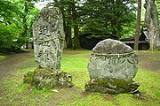
Dosojin
Encyclopedia

Shinto
or Shintoism, also kami-no-michi, is the indigenous spirituality of Japan and the Japanese people. It is a set of practices, to be carried out diligently, to establish a connection between present day Japan and its ancient past. Shinto practices were first recorded and codified in the written...
kami
Kami
is the Japanese word for the spirits, natural forces, or essence in the Shinto faith. Although the word is sometimes translated as "god" or "deity", some Shinto scholars argue that such a translation can cause a misunderstanding of the term...
popularly worshiped in Kantō and neighboring areas where, as tutelary deities of borders, they are believed to protect travelers and villages from epidemics and evil spirits. Also called , or , they are often represented as a human couple, by carved male or female genitals, large stones or statues, or even tall poles along a road.
Dōsojin can sometimes be enshrined in small roadside Shinto shrines called hokora
Hokora
A is a miniature Shinto shrine either found on the precincts of a larger shrine and dedicated to folk kami, or on a street side, enshrining kami not under the jurisdiction of any large shrine...
. When shaped like a phallus
Phallus
A phallus is an erect penis, a penis-shaped object such as a dildo, or a mimetic image of an erect penis. Any object that symbolically resembles a penis may also be referred to as a phallus; however, such objects are more often referred to as being phallic...
, they are associated with birth and procreation, and therefore marital harmony.
Sae no Kami
In modern times, Dōsojin have become fused in popular belief with a different deity having similar characteristics called "Sae no kami", whose birth is described in the KojikiKojiki
is the oldest extant chronicle in Japan, dating from the early 8th century and composed by Ō no Yasumaro at the request of Empress Gemmei. The Kojiki is a collection of myths concerning the origin of the four home islands of Japan, and the Kami...
. When kami Izanagi-no-mikoto
Izanagi
is a deity born of the seven divine generations in Japanese mythology and Shinto, and is also referred to in the roughly translated Kojiki as "male-who-invites" or Izanagi-no-mikoto. It is also pronounced Izanaki-no-Okami....
sought to leave after going to the realm of the dead (Yomi no Kuni
Yomi
, the Japanese word for the underworld in which horrible creatures guard the exits; according to Shinto mythology as related in Kojiki, this is where the dead go to dwell and apparently rot indefinitely. Once one has eaten at the hearth of Yomi it is impossible to return to the land of the living...
) to visit his spouse Izanami-no-mikoto
Izanami
In Japanese mythology, is a goddess of both creation and death, as well as the former wife of the god Izanagi-no-Mikoto. She is also referred to as Izanami-no-kami.-Goddess of Creation:...
, he was chased by the demoness . To stop her, he threw her a stick from which Sae no Kami was born. For this reason, he is the kami who prevents the passage of the spirits of the dead into the world of the living, and therefore a god who is a protector of boundaries. He is represented by large rocks set at the edges of villages. Because of the rocks' elongated shape, he came to be associated also with childbirth, children and matrimonial happiness. As a consequence, he was in turn associated also with Jizō, the Buddhist god who is the protector of children.
Jizō
Jizō is the Japanese version of BodhisattvaBodhisattva
In Buddhism, a bodhisattva is either an enlightened existence or an enlightenment-being or, given the variant Sanskrit spelling satva rather than sattva, "heroic-minded one for enlightenment ." The Pali term has sometimes been translated as "wisdom-being," although in modern publications, and...
Ksitigarbha
Ksitigarbha
Ksitigarbha is a bodhisattva primarily revered in East Asian Buddhism, usually depicted as a Buddhist monk in the Orient. The name may be translated as "Earth Treasury", "Earth Store", "Earth Matrix", or "Earth Womb"...
, a Buddhist
Buddhism in Japan
The history of Buddhism in Japan can be roughly divided into three periods, namely the Nara period , the Heian period and the post-Heian period . Each period saw the introduction of new doctrines and upheavals in existing schools...
god worshiped mainly in East Asia. His assimilation within a group of kami is an example of the Japanese syncretism
Syncretism
Syncretism is the combining of different beliefs, often while melding practices of various schools of thought. The term means "combining", but see below for the origin of the word...
of Buddhism and Shinto (shinbutsu shūgō
Shinbutsu Shugo
, literally "syncretism of kami and buddhas" is the syncretism of Buddhism and kami worship which was Japan's religion until the Meiji period...
). Originally from India, in Japan he was given new attributes, and he is known as the guardian of unborn, aborted or prematurely dead children. Often found along roads in Japan, he has become a dōsojin.
Chimata no Kami
, according to the KojikiKojiki
is the oldest extant chronicle in Japan, dating from the early 8th century and composed by Ō no Yasumaro at the request of Empress Gemmei. The Kojiki is a collection of myths concerning the origin of the four home islands of Japan, and the Kami...
, was born when kami Izanagi
Izanagi
is a deity born of the seven divine generations in Japanese mythology and Shinto, and is also referred to in the roughly translated Kojiki as "male-who-invites" or Izanagi-no-mikoto. It is also pronounced Izanaki-no-Okami....
threw away his trousers to wash himself after returning from Yomi, the land of the dead. The Nihongi and Kogoshūi tell the same myth, but call the kami Sarutahiko.

